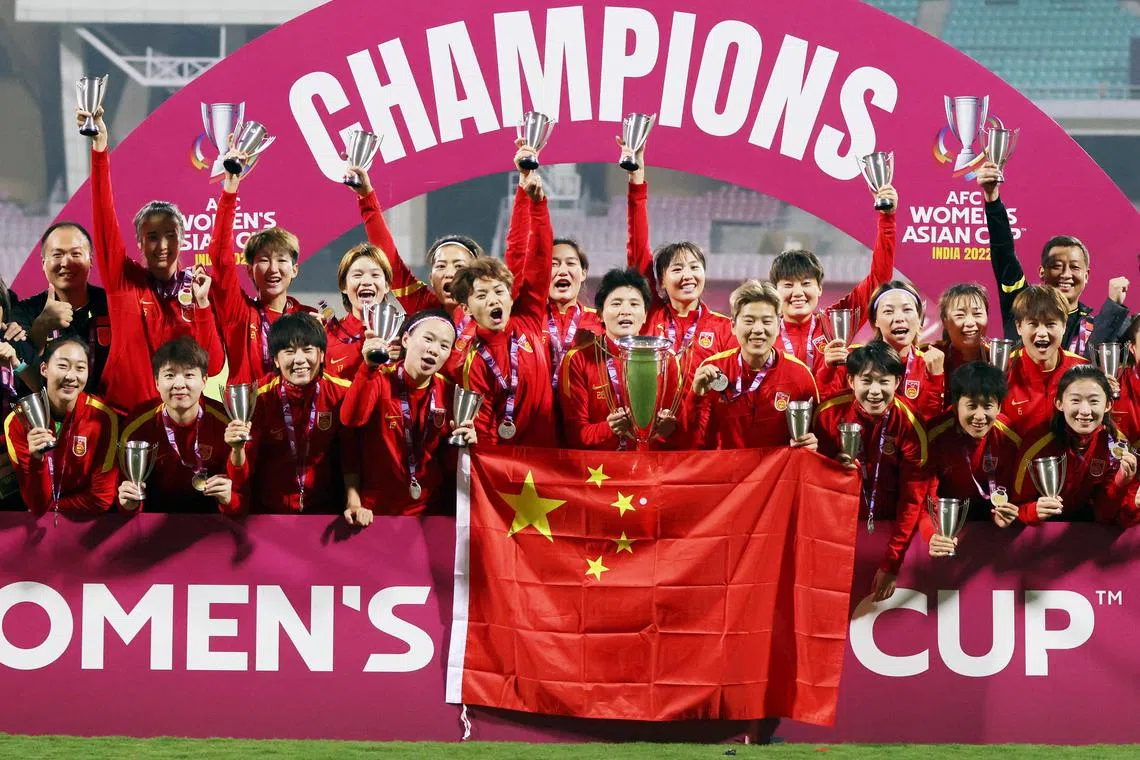‘Biggest’ Women’s Asian Cup can help drive change, says top official
Sign up now: Get the biggest sports news in your inbox

China celebrating after winning the Women's Asian Cup in 2022.
PHOTO: REUTERS
Follow topic:
HONG KONG – The Women’s Asian Cup in 2026 can help break down barriers for female players in the region, a lead organiser told AFP, saying that it will be the biggest tournament in its history.
Australia will host the 12-team competition from March 1 to 21, having successfully staged the Women’s World Cup in 2023 along with neighbours New Zealand.
That competition broke records on and off the pitch while women’s football has boomed in Europe, with this summer’s continental championship in Switzerland played out to unprecedented crowds.
Sarah Walsh, a former Australian international and now chief operating officer of the local organising committee for the 2026 tournament, admitted that Asia is playing catch-up in that respect.
This is largely because some countries in the region are lagging when it comes to gender equality in society, but football can play a positive part.
“Any time we platform women, particularly on broadcast, or in the centre of the pitch when there’s 40,000 people watching, absolutely (it can have a wider impact),” Walsh said on the sidelines of a Hong Kong football conference.
“There are still inequalities in Australia, and I think that platforming the Matildas on the world stage and where 75 per cent of Australians watch has a significant impact on social attitudes towards women.
“So when you think about that, of course it can also do it in other countries... (Football) has that ability to progress things by putting women at the forefront.”
The Australian women’s team, known as the Matildas, reached the semi-finals of their home World Cup in 2023 and regularly draw sell-out crowds, even for friendlies.
Their last-four defeat by England in Sydney was attended by 76,000 spectators while 11 million people – out of a population of 27 million – tuned in to watch.
There is no concern about the locals turning out en masse again in 2026 for the Matildas, but Walsh knows that “it will be challenging to fill out the stadiums” for some other games.
“Europe is leading the way with the Euros and I think we have a lot of catching up to do as well,” she said.
As well as the Matildas, Japan, North Korea and title-holders China will all be serious contenders.
At the other end of the scale, Bangladesh are at the Women’s Asian Cup for the first time.
“I spend more of my time thinking about this than anything else,” added Walsh about how the tournament can replicate the kinds of crowds and interest generated by the European equivalent.
Organisers have multiple plans, including drawing on Australia’s multicultural communities. And early ticket sales have been promising, said Walsh.
She told the World Football Summit in Hong Kong on Sept 3 that the 21st edition in 2026 “will absolutely be the biggest Women’s Asian Cup ever”.
But she said a one-off successful tournament, including strong television audiences in Asia, is just the start.
“You only have to look at the investment that’s happening, particularly in the Middle East, and how we think that might translate to women’s football,” she said, adding that while Saudi Arabia will not be at this Asian Cup, “it’s just a matter of time”.
“It’s all moving in the right direction.
“We have a responsibility as hosts – and also in my role on the AFC (Asian Football Confederation) women’s committee – to make sure that this isn’t just 21 days of fun but that we are progressing the development of the countries that are playing in the finals.”
The tournament will open at Perth Stadium, with the final being held at Stadium Australia in Sydney. AFP

